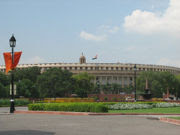Government and politics of Delhi

As a special union territory, in the same manner as that of Pondicherry, the National Capital Territory of Delhi has its own Legislative Assembly, Lieutenant Governor, Council of Ministers and Chief Minister. The legislative assembly seats are filled by direct election from territorial constituencies in the NCT. However, the Union Government of India and the Government of National Capital Territory of Delhi jointly administer New Delhi. While services like transport and others are taken care of by the Delhi Govt., services such as the police are directly under the control of the Central Government. The legislative assembly was re-established in 1993 for the first time since 1956, with direct federal rule in the span. In addition, the Municipal Corporation of Delhi (MCD) handles civic administration for the city as part of the Panchayati Raj act. New Delhi, an urban area in Delhi, is the seat of both the State Government of Delhi and the Government of India. The Parliament of India, the Rashtrapati Bhavan (Presidential Palace) and the Supreme Court of India are located in New Delhi. There are 70 assembly constituencies and seven Lok Sabha (Indian parliament's lower house) constituencies in Delhi.[31][32]
Delhi was a traditional stronghold of the Indian National Congress, also known as the Congress Party. In the 1990s the Bharatiya Janata Party (BJP) under the leadership of Madan Lal Khurana came into power. However in 1998, Congress regained power. Sheila Dixit of Congress is the incumbent Chief Minister. The Congress retained power in the Legislative Assembly in the 2003 election as well by a large margin. However, in 2007, the BJP scored a crushing victory over the ruling Congress in the MCD election. Both parties have advocated full-fledged statehood for Delhi, but the process to establish this has been slow. The next election are slated to take place soon and this has heated up the politics of the city.
Source from http://en.wikipedia.org
0 comments: